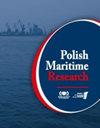Exploration of a Model Thermoacoustic Turbogenerator with a Bidirectional Turbine
IF 2
3区 工程技术
Q2 ENGINEERING, MARINE
引用次数: 0
Abstract
Abstract The utilisation of the thermal emissions of modern ship power plants requires the development and implementation of essentially new methods of using low-temperature waste heat. Thermoacoustic technologies are able to effectively use low-temperature and cryogenic heat resources with a potential difference of 500–111 K. Thermoacoustic heat machines (TAHMs) are characterised by high reliability, simplicity and environmental safety. The wide implementation of thermoacoustic energy-saving systems is hampered by the low specific power and the difficulties of directly producing mechanical work. An efficient approach to converting acoustic energy into mechanical work entails the utilisation of axial pulse bidirectional turbines within thermoacoustic heat engines. These thermoacoustic turbogenerators represent comprehensive systems that consist of thermoacoustic primary movers with an electric generator actuated by an axial-pulse bidirectional turbine. The development of such a thermoacoustic turbogenerator requires several fundamental issues to be solved. For this purpose, a suitable experimental setup and a 3D computational fluid dynamics (CFD) model of a thermoacoustic engine (TAE) with bidirectional turbines were created. The research program involved conducting physical experiments and the CFD modelling of processes in a TAE resonator with an installed bidirectional turbine. The boundary and initial conditions for CFD calculations were based on empirical data. The adequacy of the developed numerical model was substantiated by the results of physical experiments. The CFD results showed that the most significant energy losses in bidirectional turbines are manifested in the output grid of the turbine.探索带双向涡轮的热声涡轮发电机模型
摘要 现代船舶发电厂热排放的利用需要开发和实施新的低温废热利用方法。热声技术能够有效利用电位差为 500-111 K 的低温和低温热资源。热声热机(TAHM)的特点是可靠性高、操作简单和环保安全。热声节能系统的广泛应用受到比功率低和难以直接产生机械功的阻碍。将声能转化为机械功的有效方法是在热声热机中利用轴向脉冲双向涡轮。这些热声涡轮发电机是由热声原动机和由轴向脉冲双向涡轮驱动的发电机组成的综合系统。开发这种热声涡轮发电机需要解决几个基本问题。为此,我们创建了一个合适的实验装置和带有双向涡轮的热声发动机(TAE)的三维计算流体动力学(CFD)模型。研究计划包括在安装了双向涡轮机的热声发动机(TAE)谐振器中进行物理实验和 CFD 过程建模。CFD 计算的边界和初始条件以经验数据为基础。物理实验结果证明了所开发数值模型的适当性。CFD 结果表明,双向涡轮机最显著的能量损失体现在涡轮机的输出电网上。
本文章由计算机程序翻译,如有差异,请以英文原文为准。
求助全文
约1分钟内获得全文
求助全文
来源期刊

Polish Maritime Research
工程技术-工程:海洋
CiteScore
3.70
自引率
45.00%
发文量
20
审稿时长
>12 weeks
期刊介绍:
The scope of the journal covers selected issues related to all phases of product lifecycle and corresponding technologies for offshore floating and fixed structures and their components.
All researchers are invited to submit their original papers for peer review and publications related to methods of the design; production and manufacturing; maintenance and operational processes of such technical items as:
all types of vessels and their equipment,
fixed and floating offshore units and their components,
autonomous underwater vehicle (AUV) and remotely operated vehicle (ROV).
We welcome submissions from these fields in the following technical topics:
ship hydrodynamics: buoyancy and stability; ship resistance and propulsion, etc.,
structural integrity of ship and offshore unit structures: materials; welding; fatigue and fracture, etc.,
marine equipment: ship and offshore unit power plants: overboarding equipment; etc.
 求助内容:
求助内容: 应助结果提醒方式:
应助结果提醒方式:


